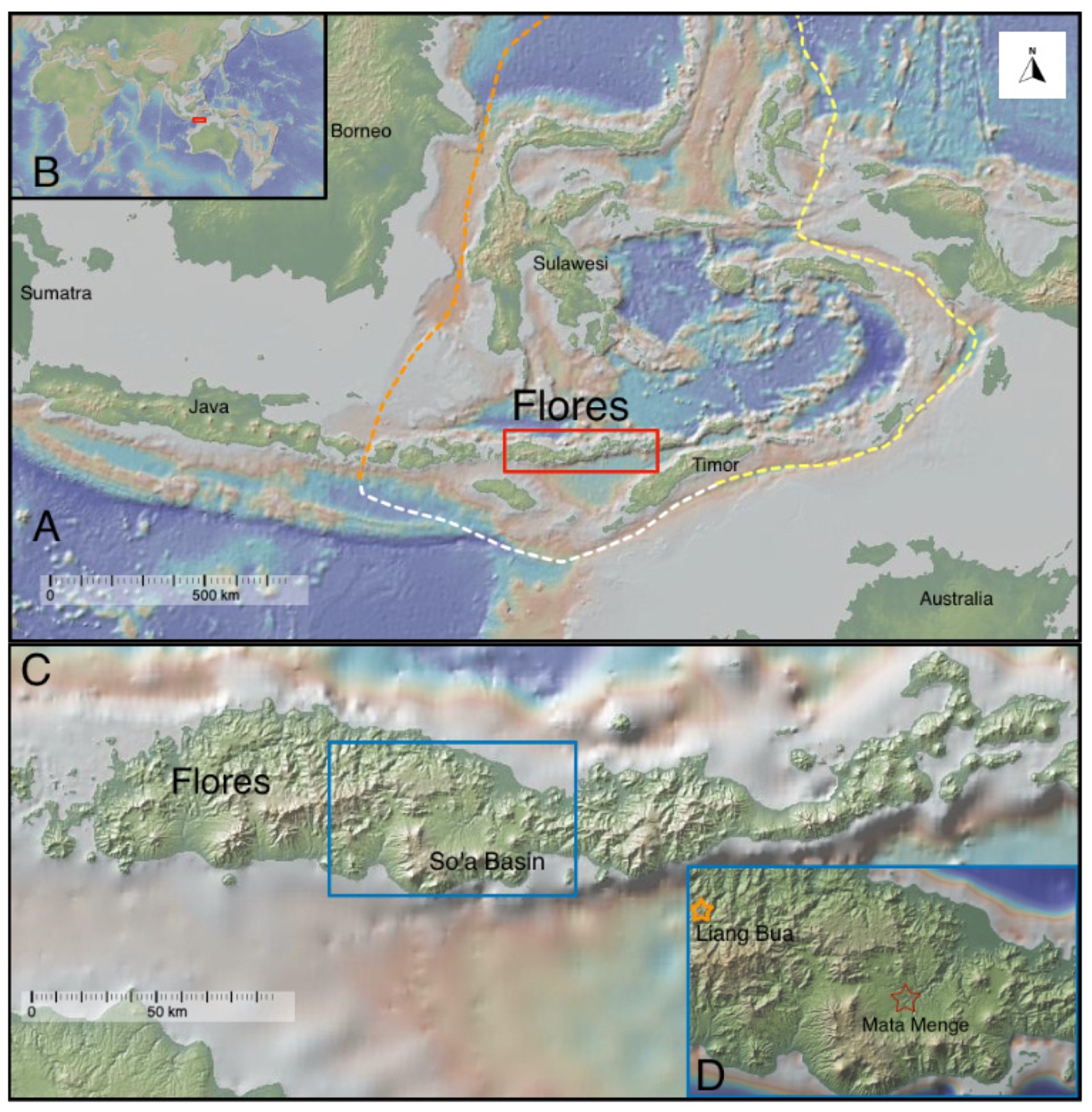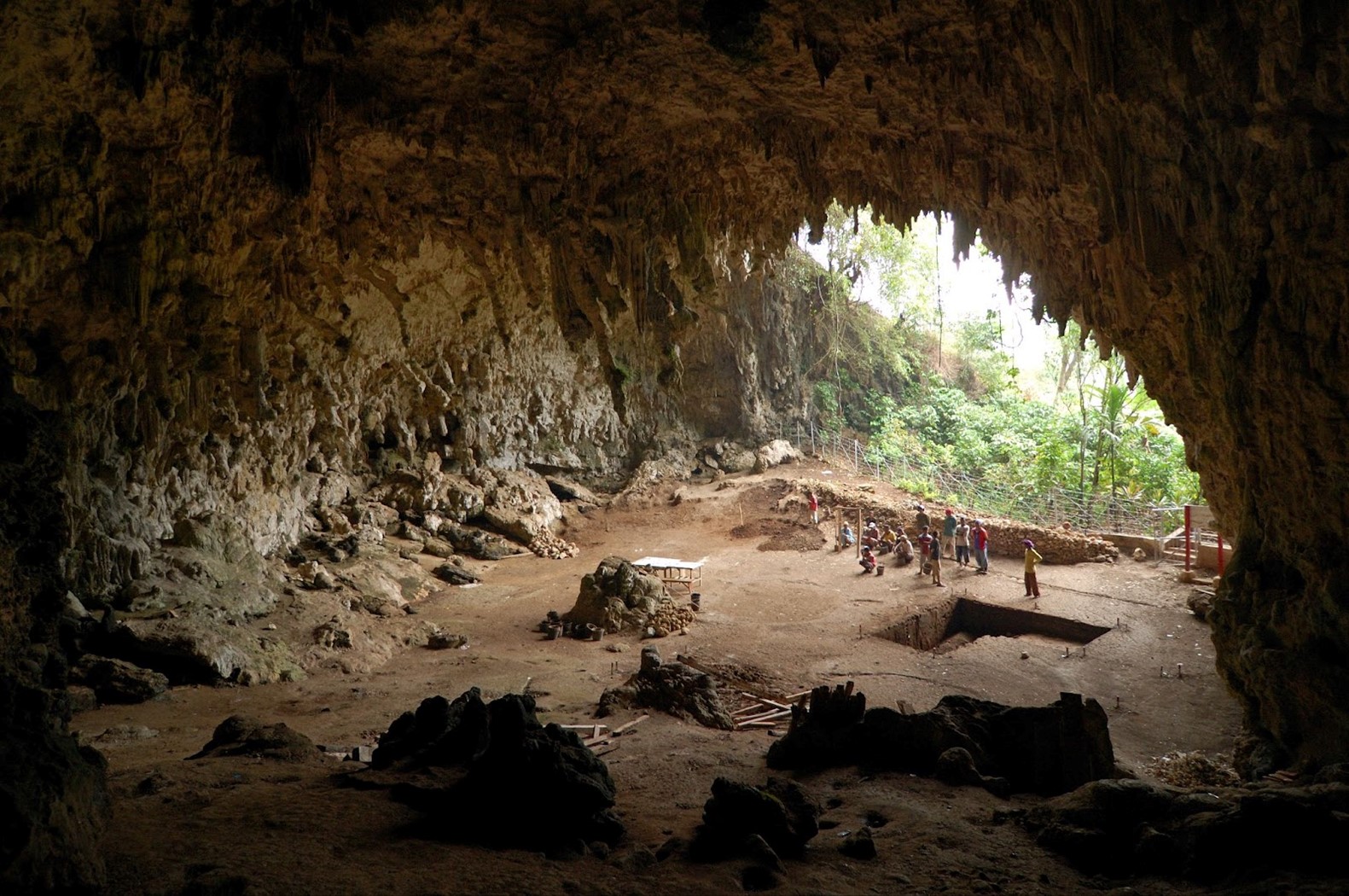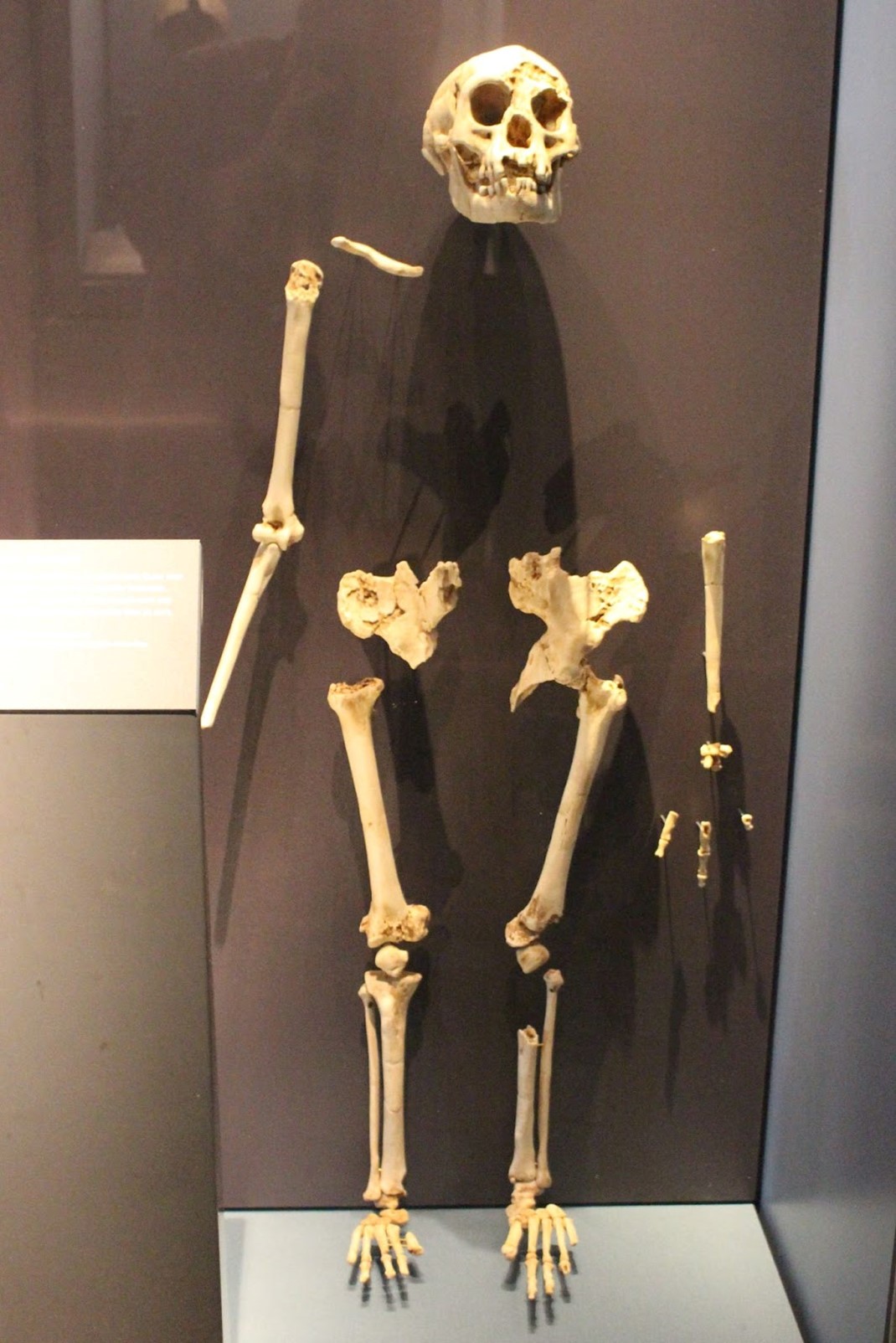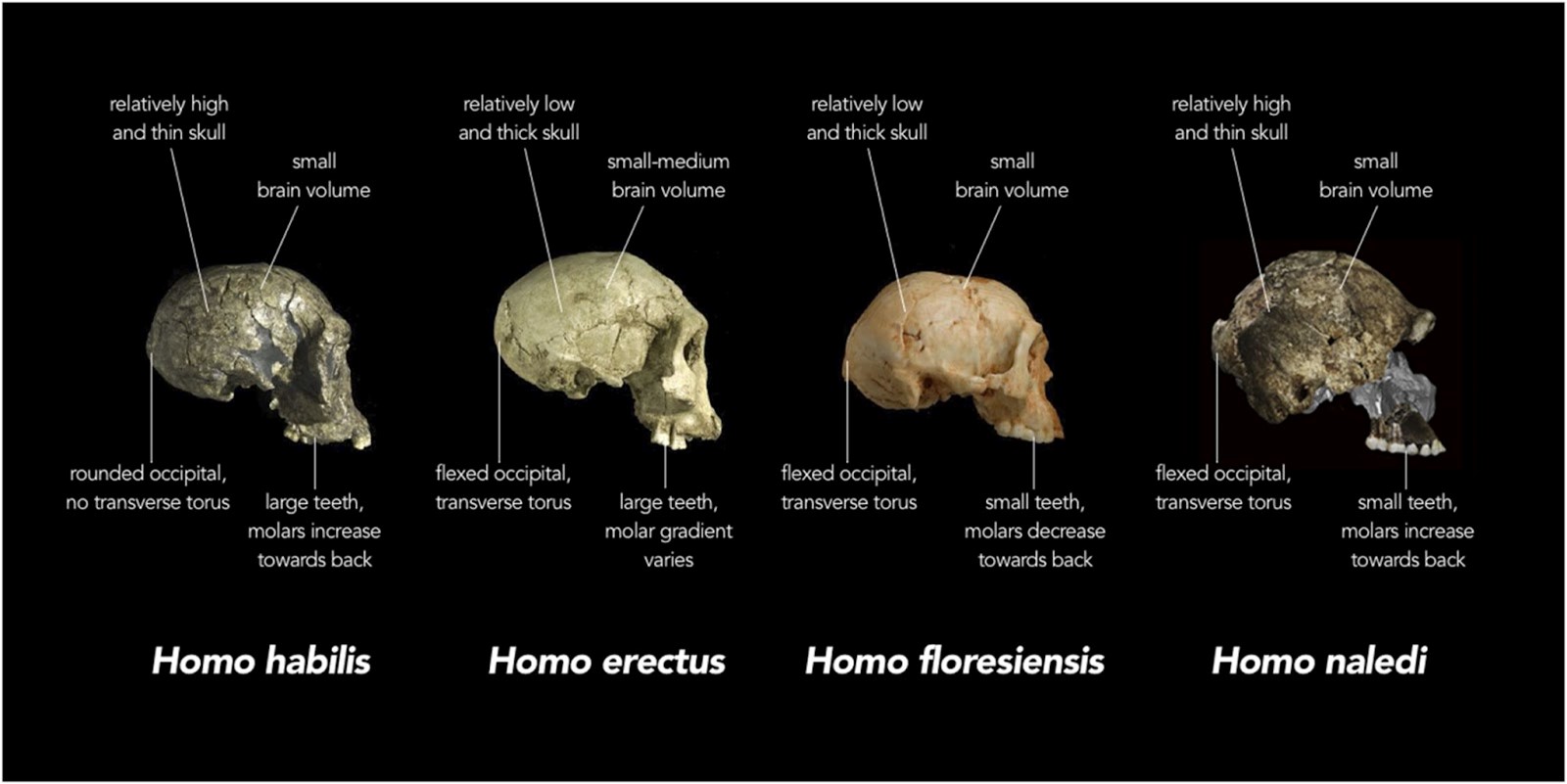Background
Synopsis: On a previous EarthDate episode, we talked about the Wallace Line and how species spread, or rather, didn’t spread across this boundary in the Indonesian archipelago. But what about humans? How did early hominins develop in this region? Archeologists are still uncovering the details.
- In 2003, scientists explored the Liang Bua cave on the Indonesian island of Flores which lies west of the Wallace Line. The expedition was led by the late New Zealand archaeologist, Mike Morewood, and discovered what was dubbed as the “hobbit” species due to its diminutive stature. Around the same time, the Lord of the Rings film trilogy was widely popular, and the discovery's nickname resonated with the cultural fascination with hobbits.

Inset B shows the location of Flores off the northwest coast of Australia. Inset D shows the location of the earlier discovery of Homo floresiensis in the Liang Bua cave and the more recent discovery at the Mata Menge site.
Credit: Meagan J. Powley, Indra Sutisna, Katarina M. Mikac, Unggul Prasetyo Wibowo, Gerrit D. van den Bergh, CC BY 4.0, via Wikimedia Commons
A view inside the large Liang Bua cave and the work of unearthing fossils believed to be from 14 different individuals.
Credit: Felix Dance, CC BY 2.0, via Wikimedia Commons- With a height of slightly over 1 meter (3 feet), the team first thought the skeletal remains may have been from a small child, but analysis of the bone structure and the presence of wisdom teeth, confirmed that it was indeed from an adult.
- The age of the fossils suggests that they lived on the island 60,000 to 100,000 years ago yet oddly disappeared about 50,000 years ago based on stone tools found in the area.
- Over 100 early human fossils were found in the cave that were likely fragments from 14 individuals. The most complete fossil found are the remains of a female specimen.
- This unique branch of the human lineage was named Homo floresiensis, named after the island where they have been found.
- This discovery, which the team kept secret for over a year, challenged the understanding of human development, that is, that development was more complex than a single linear path and that there were more than regional differences between hominin species.
- Some questioned the discovery and believed that the bones were from a modern human that suffered from growth disorder. The debate took years to resolve but evidence of other small bodied and small brained hominin fossils in South Africa and the Philippines have reinforced the idea that there have been many diverse species of humans.
- The Morewood team proposed that the population evolved from Homo erectus by traveling to Flores from Java. In a process called island dwarfism, they evolved smaller and smaller bodies due to limited resources. Also known as insular dwarfism, this idea is supported by fossil evidence of dwarf elephants (Stegodon florensis insularis) found in the region as well.
- With no other modern human remains found in the region dating to this time, it seems that Homo floresiensis became extinct.

The most complete skeleton found by the Morewood team on Flores was first believed to be a small child with its small skull and a height of just over 1 meter (3 feet). Later analysis confirmed that the remains were from a female adult.
Credit: Emőke Dénes, CC BY-SA 4.0, via Wikimedia Commons
The H. floresiensis has a distinctly smaller brain volume and small teeth compared to its ancestor H. erectus from mainland Asia.
Credit: Chris Stringer, Natural History Museum, United Kingdom, CC BY 4.0, via Wikimedia Commons
- A decade later, and about 45 miles from the Liang Bua cave, researchers made another significant discovery at the Mata Menge excavation site on Flores, unearthing fragments of older "hobbits."
- A fragment of an adult humerus, the long bone in the upper arm, along with many small teeth were discovered at the open-air site. The length of the arm bone allowed researchers to determine that the adult had a height of just 1 meter (3 feet, 3 inches). The skeleton found earlier in the Liang Bua cave was thought to be 6 cm (2.4 inches) taller based on the size of the femur or thigh bone.
- This humerus and teeth found are estimated to be 700,000 years old, significantly older than the fossils found in the Liang Bua cave.
- The study’s co-author, Adam Brumm from Griffith University’s Australian Research Center for Human Evolution, said that “This 700,000-year-old adult humerus is not just shorter than that of Homo floresiensis, it is the smallest upper arm bone known from the hominin fossil record worldwide.”
- Further studies of the teeth have verified that these are much earlier ancestors of the hobbit species, H. floresiensis, and that they did, in fact, descend from H. erectus rather than an ancestral African species.
- Primarily through dental analysis, it is estimated that the species first appeared on this island in Wallacea about one-million years ago and rather quickly (300,000 years) exhibited a small body size. This was despite evidence of some large predators such as Komodo monitors that fossils show were over 3 meters (9.8 feet) long and lived on the island during the same time.
- When isolated on islands, tremendous changes are common in both humans and other animals. For example, a now extinct dog-sized rat found on the island of East Timor is an example of island gigantism, as opposed to island dwarfism as mentioned earlier seen in elephants in the region of Wallacea.
- Stone tools found at Mata Menge alongside the fossils were very similar to tools found at the Liang Bua cave site. Across Flores, tools that are one million years old indicate that the species had been on the island and lived on the island for hundreds of thousands of years.
- This isolation and resulting adaptation of Homo floresiensis provides a very unique fossil record of human evolution with a restricted environment.
Paleoanthropologists are eagerly awaiting further discoveries on human evolution as research progresses in the So’a Basin on Flores, an even older site. Many questions remain, including how survival was sustained in this volcanic region for over a million years and how the development of the hobbit-like species occurred.
“Even the smallest person can change the course of the future.”
― J.R.R. Tolkien, The Lord of the Rings
Episode Script
On the island of Flores, in Indonesia, a team of anthropologists made a discovery so surprising, they kept it a secret for a year.
In a cave called Liang Bua, they had uncovered 100 skeletal fragments of about 14 individuals – so small, that at first, they thought they might be the remains of children.
But more investigation showed wisdom teeth and wear on bones that definitively marked these skeletons as adults – and a newly discovered species of hominin, just over 3 feet tall.
They called them Homo floresiensis, after the island. But they nicknamed them hobbits, and the moniker stuck.
This community of hobbits had lived on Flores from about 100,000 years ago until just 50,000 years ago, then went extinct.
More recent discoveries on the island found the hobbits’ even smaller ancestors, who arrived between 1 million and 700,000 years ago, and quickly shrank in size, in a process called island dwarfism, where species get smaller in response to limited resources.
Indonesia also once had dwarf elephants and other creatures.
But the presence of the hobbits, at a time when Homo sapiens were already well established in Africa, Europe and the Middle East, and venturing into Australasia, shocked the anthropology world.
And reminded us that, for hundreds of thousands of years, there were several kinds of successful humans on Earth -- before our kind became the sole survivor.

